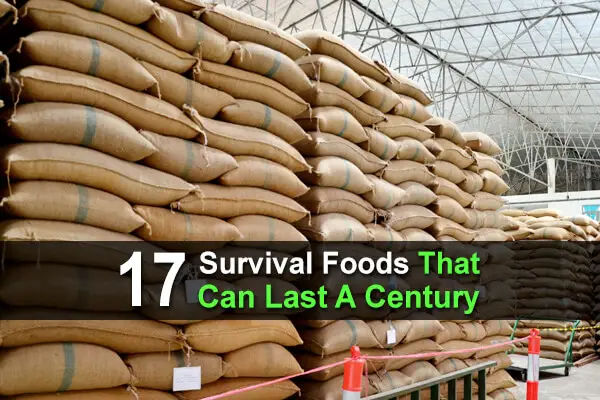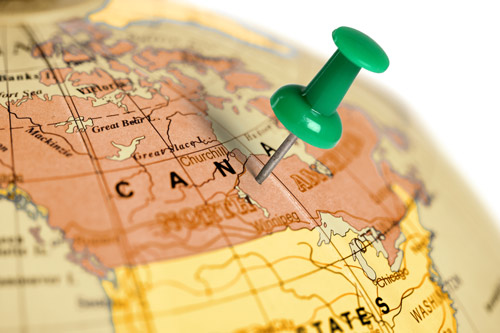When it comes to stockpiling food, shelf life is by far one of the most important factors. While most foods will have a limited shelf-life, there are a few survival foods that can be safely stored for more than one hundred years.
If you are looking for foods that you never have to worry about going bad, check out these seventeen survival foods that can last a century.
However, before you go out and start buying them, keep in mind that these foods will only last a century if they’re stored properly. Be sure to read the food storage section at the end of the article for more information.
Note: A lot of people have pointed out that many of these aren’t actually foods; they’re ingredients. I guess by food, I meant anything that you can ingest. If you can’t eat it by itself, you can at least use it in a recipe.
Want to save this post for later? Click Here to Pin It On Pinterest!
1. Alcohol
As most people know, wine gets better the older it gets. However, over time, the fruitier flavors will fade, leaving behind the non-fruity flavors, which could be good or bad, depending on the wine. Base liquors (brandy, gin, vodka, whiskey, etc.) will last indefinitely if stored in tightly sealed bottles in a cool, dark place.
Beer, on the other hand, will not last 100 years. At best, it will last a few years if refrigerated and only a year or so when not refrigerated. Besides being a drink, alcohol has other survival uses—it can disinfect wounds, act as a fire starter, and even serve as a cleaning agent.
2. Apple Cider Vinegar
Apple cider vinegar is probably one of the healthiest foods in the world. It has tons of health benefits and literally over 100 uses, so even if you don’t cook with it, it’s still worth stockpiling.
With its antimicrobial and acidic properties, apple cider vinegar can help with digestion, soothe bug bites, and act as a natural cleaner for surfaces or tools. When stored in tightly sealed glass bottles and kept in a cool, dark space, it has an indefinite shelf life.
3. Baking Soda
Baking soda is an important ingredient in a wide range of recipes as well as a versatile product that can be used for everything from cleaning to personal hygiene. Here’s a list of uses for baking soda. When stored in airtight containers, baking soda won’t ever go bad.
Transfer your baking soda from the cardboard carton it comes in to a more permanent container and keep it in a cool, dry place. In survival scenarios, baking soda can also be used to neutralize odors, extinguish small grease fires, or act as a mild abrasive for cleaning tough surfaces.
4. Beans
Specifically, dried beans, which are listed as having an indefinite shelf-life when stored in airtight containers. However, dried beans do begin to lose their moisture after a few years in storage, meaning they might not have the same taste and texture after a certain point. Nevertheless, they will remain edible, making dried beans a great survival food to stockpile.
To maximize their storage life, consider vacuum-sealing them with oxygen absorbers and storing them in a cool, dark space. While older beans might take longer to cook, their nutritional value remains intact, making them a reliable protein source during emergencies.
5. Corn Starch
Cornstarch is a great ingredient for thickening sauces and adding flavor to various dishes. It also never goes bad. However, since most cornstarch is sold in cardboard cartons that will break down over time, you may want to transfer your cornstarch to a more permanent container before storing it. In addition to cooking, cornstarch can be used as a natural remedy for rashes and irritation or to help keep stored goods dry by absorbing moisture.
6. Corn Syrup
Corn syrup might not be the healthiest food, but it is a great sweetener that never goes bad. Store your corn syrup in a cool, dry area and it will have an indefinite shelf life. Besides being used in recipes, corn syrup can act as a binder for homemade energy bars, making it a useful addition to your survival pantry.
7. Ghee
Ghee is a form of butter that originated in South Asia. Unlike traditional butter, ghee never goes bad since all of the moisture is evaporated out. Store your ghee in a cool, dry place and you will always have a tasty butter substitute available.
For long-term storage, glass jars are preferable over plastic containers. In a survival situation, ghee can also double as a fuel for lamps, providing light when electricity isn’t an option.
8. Honey
Honey may crystallize and begin turning to sugar over time, but it never really goes bad. Simply heating the honey in warm water will dissolve these crystals in a matter of minutes.
Stored in either plastic or glass jars, honey has an indefinite shelf life, meaning you can enjoy a sweet treat no matter how many years have gone by. Beyond its use as a sweetener, honey has antimicrobial properties and can be applied to wounds or burns to aid in healing and prevent infections.
9. Instant Coffee
If you are one of the many people that rely on a cup of coffee each morning to kickstart your day, you’ll be happy to know that instant coffee never spoils when stored properly.
To keep instant coffee from going bad, you will have to store it in vacuum-sealed bags that are kept in a freezer. Coffee can also be used as a bartering item during long-term crises, making it not just a luxury but a potential trade good.
10. Maple Syrup
Maple syrup is similar to honey in many ways. It can be stored indefinitely without going bad when kept in a cool, dry place but may begin to crystallize over time. As with honey, a little warm water is all it takes to dissolve the crystals.
Besides being a sweetener, maple syrup is a high-energy food source that pairs well with other long-lasting foods like rice or beans, making it a versatile survival staple.
11. Popcorn
To be honest, making this one last a century might be difficult. It needs to be plain popcorn kernels without any seasoning, and it needs to be completely vacuum sealed and kept cool and away from any moisture.
But technically, it’s possible to make it last for decades or even longer. Properly stored popcorn is not just a snack but can also serve as a grain alternative in survival situations. Grinding the kernels into cornmeal is another option if cooking flexibility is needed.
12. Rice
Rice is a staple survival food, thanks in part to the fact that it is cheap and filling. However, rice is also an ideal survival food thanks to its indefinite shelf life. Before they are opened, bags of rice will last forever when stored in a cool, dry place.
After opening a bag of rice, you’ll have to transfer it to a freezer to keep it from spoiling. For best results, store white rice in mylar bags with oxygen absorbers to keep it fresh and pest-free for decades.
13. Salt
Salt will last an eternity in storage—which makes sense given that salt is often mined from the earth after resting beneath the ground for untold amounts of time. However, make sure you get non-iodized salt. Even though the salt lasts forever, the iodine will go bad after five years.
Simply store your salt in a cool, dry area and it will never go stale. Be sure to get sea salt, which retains more nutrients than ordinary table salt. Salt is also essential for preserving foods, curing meats, and pickling vegetables in survival scenarios.
14. Soy Sauce
Due largely to its high sodium content, soy sauce has an indefinite shelf life, so long as it remains unopened. Simply store your soy sauce in a cool, dry area and it will never spoil. Soy sauce is also an excellent ingredient for adding flavor to otherwise bland foods, making it an indispensable item in your survival pantry.
15. Sugar
Despite the fact that cells survive on a form of sugar—glucose—sugar itself does not support the growth of bacteria. This means that all forms of sugar—including white, brown, and powdered sugar—will last forever when kept in an airtight container and stored in a cool, dry area.
Sugar is also a key ingredient for preserving fruits, adding calories to meals, or creating morale-boosting treats in survival situations.
This stuff is essential if you like to bake or make pancakes. When stored properly, pure vanilla extract will never spoil. However, it is essential to ensure that you really are purchasing pure vanilla extract as opposed to artificial vanilla extract, since the artificial stuff only has a shelf life of three to four years.
If you purchase the real thing and store it in a cool, dry place, it won’t ever spoil. The comforting aroma of vanilla can also help mask unpleasant odors in confined spaces.
17. White Vinegar
White vinegar is a necessary ingredient for many recipes and a versatile cleaning supply as well. It has lots of uses around the house. It also lasts forever when stored properly—which entails keeping your vinegar in a tightly sealed container and storing it in a cool, dry place. White vinegar is also ideal for pickling, disinfecting surfaces, and even repelling certain pests like ants.
Food Storage Tips
Did I mention storing your food in a cool, dry place? This is incredibly important.
- Do not store your food in the garage, attic, shed, or any place that will get hot in the summer.
- Do not store your food near windows or anywhere with direct sunlight.
- Do not store your food in the laundry room, basement, or any room with lots of humidity.
- Do not store your food in places that could get mold or pests of any kind.
Obviously, there are many ways to store food, but for the dry foods listed above, your best bet is to put them in Mylar bags with oxygen absorbers and put those in food grade buckets with lids. (The liquids can stay in their bottles; just put them in a location withe criteria listed above.)
To store your dry foods, do the following:
- Pour your foods into the Mylar bags until all your bags are almost full (leave an inch of space at the top).
- Write the names of the foods on the sides of the bags so you don’t forget what’s what.
- Use an iron or a hair straightener to start sealing the bags, but only seal them about 2/3 across.
- Open the pack of oxygen absorbers and put one or two into each bag, depending on how many you have.
- Use a vacuum hose to suck as much air out of the bag as possible, then finish sealing it.
- Repeat the last step with the rest of the bags.
- Put your sealed bags into the food grade buckets. Fit as many into the buckets as you can.
- Use a rubber mallet to pound the lids into place.
As long as you do these things, the foods listed above should last at least a century. One more thing, don’t forget to rotate your food.
Like this post? Don’t Forget to Pin It On Pinterest!
Read the full article here













